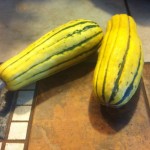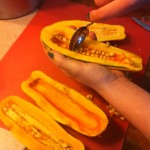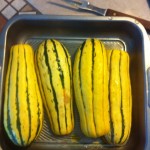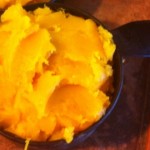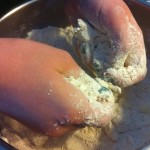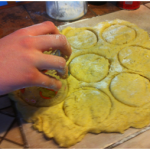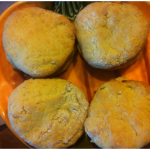This Meatless Monday, we feature winter squash, with growing, storage and prep tips, as well as recipes for Winter Squash Biscuits and the Simplest Squash from Vermont Fresh: A Fruit and Vegetable Handbook.
Background
“Winter squash” is a broad term that encompasses many different types of squash. Well-known varieties include butternut, delicata, hubbard, acorn, and spaghetti squash. Pumpkins are also a type of winter squash, though only certain varieties of pumpkin are suitable for eating. Most large pumpkins are tough and bitter, but some smaller varieties are quite tasty. Many other varieties of winter squash are commonly used in recipes that call for pumpkin (though pumpkin is not always a good substitute in a recipe calling for squash). Part of the cucurbit family, winter squash is related to gourds, cucumbers, and melons. Some types of winter squash are actually quite close relatives of summer squash, a major difference being that winter squash is allowed to mature and form a hard shell while summer squash is harvested sooner. Winter squash, along with corn and beans, was one of the “three sisters” vital to the diet of Native Americans. It is one of the first crops to ever have been cultivated in the Americas; archaeologists have uncovered seed remnants that are believed to date back thousands of years.
Growing Tips
Winter squash has a long growing season, typically requiring from 90—120 days to reach maturity, so it is best to start seeds indoors as long as a month before the final frost date. Start seeds in relatively sizable pots with plenty of compost to nourish the seedlings as they grow. Plant outdoors once all danger of frost has passed, direct seed or plant seedlings into hilled-up mounds of soil. Squash plants like plenty of organic matter and warmth. Some growers choose to grow squash in black plastic mulch to increase temperatures and keep weeds from overtaking the sprawling vines. Use floating row cover to ward off cucumber beetles early in the season but remove it once plants flower. Fruits should be harvested with 1-2 inches of stem, when rich in color with a sturdy rind, prior to the first frost.
Storage
After harvest, most types of winter squash should be “cured” in a warm, dry spot for several days (outside if the weather is nice). Squash should then be moved to a cool (around 55°), relatively dry place. Undamaged squash stored this way can last months. Squash can also be cooked, then pureed or diced, and frozen.
Nutritional Benefits
Winter squash provides complex carbohydrates, dietary fiber, vitamins A and C, several types of vitamin B, potassium, manganese, folate, and omega 3 fatty acids. It really packs a punch!
Preparation
Except delicata, most squash is peeled. Some with smooth skins, like butternut, can be tackled with a vegetable peeler before cooking. For most types, however, you’ll want to slice the squash in half vertically with a sharp knife (careful!), scoop out the seeds, and then roast or steam the pieces until the flesh softens. At that point, you can scoop it out of the skin and put it to use.
Meatless Monday Recipe: Winter Squash Biscuits
Orielle Koliba, a volunteer cooking, tasting and testing recipes out of the Vermont Fresh Handbook tested this recipe. She is a 7th grade student at Crossett Brook Middle School doing a service learning project on food security. Her comments are in italics within the recipe.
- Photo courtesy of Orielle Koliba
- Photo courtesy of Orielle Koliba
- Photo courtesy of Orielle Koliba
- Photo courtesy of Orielle Koliba
- Photo courtesy of Orielle Koliba
- Photo courtesy of Orielle Koliba
- Photo courtesy of Orielle Koliba
- Photo courtesy of Orielle Koliba
Serves 8
(adapted from New England Home Cooking and simplylifeblog.com)
Ingredients
- 1 winter squash
- 4 tablespoons olive or vegetable oil
- 1 cup all-purpose flour
- 1 cup whole wheat flour
- 2 tablespoons brown sugar
- 1 tablespoon baking powder
- 1 teaspoon salt
- ½ teaspoon pepper
- ¼ teaspoon nutmeg
- 4 tablespoons cold butter, cut into chunks
- 5 tablespoons milk
Instructions
- Preheat oven to 400°F. Carefully cut squash in half lengthwise and scoop out the seeds. Use a splash of the oil to grease a rimmed baking pan.
- Place the squash halves cut side down on the baking sheet, add a splash of water, and cook until completely soft, about 45 minutes. It took me about 30 minutes because I used two delicata squash instead of one butternut squash. When squash is cool enough to handle, scoop flesh from skin and set aside. You only need a cup of squash.
- Mash the reserved cup of squash with a potato masher or fork. Add the milk and stir. Set aside.
- In a separate bowl, stir together the flour, brown sugar, baking powder, salt, pepper, and nutmeg. Incorporate the butter with your fingers, a fork, or a pastry blender to make a coarse meal. Add the oil. Set aside.
- Stir the squash mixture into the dry ingredients with a fork, forming a soft dough. Don’t over knead.
- Pat the dough out on a lightly floured surface until it is about ¾ inches thick.
- Cut into round biscuits with a biscuit cutter or a glass, lumping together scraps and patting out the dough again until you have used it all up.
- Place biscuits on a greased baking sheet and bake until golden brown, about 15—20 minutes. Serve warm, with butter.
They tasted really good! This recipe could be even faster if the squash was already cooked. Also make sure the dough is ¾ inch thick before stamping the biscuits because I made mine too thin.
It took about 5 minutes to prep the squash, 30 minutes to bake them, 15 minutes to make the dough and 15 minutes to bake them.
Costs
Delicata: $3.00
Butter: $0.50
Flour, oil, milk, sugar, salt, pepper, baking soda nutmeg: Estimated $2.50
Total Cost: $6.00
Meatless Monday Recipe: Simplest Squash
Serves 4—8
Ingredients
- 2 large winter squash
- 2 tablespoons olive oil
- 1 teaspoon salt
- ½ teaspoon pepper
- 2 tablespoons maple syrup
Instructions
- Preheat oven to 425°. Cut squash in half, scoop out seeds, and chop into pieces.
- Toss pieces with olive oil, sprinkle with salt and pepper, and roast for 15 minutes.
- Remove from oven, drizzle with maple syrup, then return to oven and cook until totally tender. Serve hot with additional salt and pepper.
To receive more recipes and tips on your favorite fruits and vegetables, download Vermont Fresh: A Fruit and Vegetable Handbook. We also need more volunteer home chefs for this project.
Vermont Foodbank fresh food initiatives would not be possible without your support. Please consider giving to the Vermont Foodbank today!

